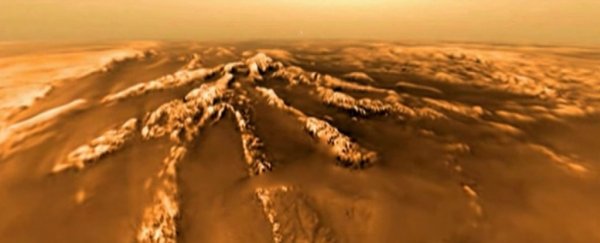Mysterious streaks covering the surface of Titan, Saturn's largest moon, could have been formed by freakish weather patterns and rainfall, according to new research.
These mazes of valleys, channels, and peaks have been puzzling scientists ever since they were first glimpsed by the Cassini probe back in 2004, and the satellite recently completed a more detailed map of the labyrinth-like terrain for scientists to study.
The terrain actually matches up with several spots on Earth, including the site of the Arecibo telescope in Puerto Rico, and those similarities have helped experts as they try and work out what's been happening on Titan.
Researchers from NASA's Jet Propulsion Laboratory and several universities in France presented their latest findings to the Lunar and Planetary Science Conference (LPSC) in March, findings based on simulations of the surface.
 Titan's mazes match up with parts of Earth. Image: NASA Jet Propulsion Laboratory
Titan's mazes match up with parts of Earth. Image: NASA Jet Propulsion Laboratory
"When we first saw [the streaks], we knew the terrain was special," Cassini team member Michael Malaska, from JPL, told Nola Taylor Redd at Space.com.
Based on studies over a number of years, it seems several processes could be at work.
One is dissolution: liquid methane and ethane, raining from the sky on Titan, and then dissolving organic material on the ground. To begin with, isolated pits would form, gradually merging to create channels.
Wind is likely to also play a part, the researchers say, matching similar processes here on Earth.
Another contributing factor could be sublimation: that's where frozen material jumps from a solid to a gas without hitting the liquid stage in between, creating cracks or troughs in the landscape along the way.
Sublimation is thought to help shape the surface at the poles of Mars, though as temperatures on Titan are much lower, it probably played less of a role here.
Having extensively studied the terrain, experts say some of the valleys on Titan's surface are open and connected, while others are closed off and separate, and that backs up the idea that more than one process is at work.
To put the dissolution hypothesis to the test, scientists ran a 3D model using data gleaned from Cassini and what we know about weather cycles here on Earth.
When comparing the results of the simulation with photographs from Titan, the scientists found the two matched up well, although the timescales still aren't clear – perhaps not surprising as we don't know much about rainfall rates on Titan.
If the rainfall rates match those on Earth, the strange mazes on Titan could've formed in a few million years, the model suggests.
But as the labyrinth-like channels are thought to be billions of years old though – some of the oldest features on the moon – it probably took much longer than that.
Once we know more about the atmospheric conditions and surface composition of Titan, scientists can explore these mysteries in more detail. We can't rely on Cassini any more though, as it will be crashing into Saturn's surface later this year.
It's not the only occasion when we've caught a fascinating glimpse of a planet's surface without being able to explain the terrain: there's a strange, deep hole on Mars that so far has left scientists scratching their heads.
Still, we like the idea of having these space mysteries to solve – the Universe would be a much less interesting place if we knew everything about it.
